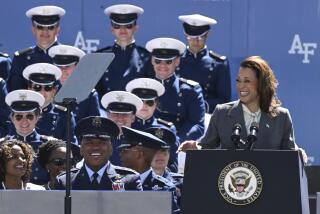Critics Ignored as President Clung to Secrecy
- Share via
WASHINGTON — For months, President Bush and his advisers have absorbed a drumfire of criticism for failing to seize the opportunity to relax East-West tensions presented by Soviet President Mikhail S. Gorbachev’s reform policies.
And for all those months, Bush has kept to himself knowledge that would have silenced many of those critics--the fact, disclosed Tuesday, that since July he has been planning to hold a summit meeting with Gorbachev in December.
“I’ve elected to remain very quiet in the face of a good deal of sentiment that we were missing an opportunity,” Bush said in his press conference Tuesday. “We’ve known what we’re doing. . . . And if people see that a little more clearly now, so be it.”
The Administration’s desire and ability to keep the summit plans secret from July nearly to November reveal much about the President’s way of conducting foreign policy--his penchant for secrecy, his desire to work almost exclusively with a tiny core group of advisers and the self-confidence that has allowed him to live with criticism without feeling a need to respond.
Bush took evident delight in his Administration’s ability to keep news of the summit from leaking. “Since July it’s been in the works,” a broadly grinning Bush told reporters during his press conference Tuesday. “You just haven’t been told.”
Planning for the meeting began after Bush’s visit to Eastern Europe in July, a senior Administration official said. Touring Poland and Hungary, Bush was exposed directly to the tremendous changes taking place there. In one meeting, Hungarian officials presented him with a piece of barbed wire snipped from the Austro-Hungarian border fences that the new Hungarian government had torn down.
In other meetings, Lech Walesa, the leader of Solidarity, and Hungarian reform leader Imre Poszgay both urged Bush to meet with Gorbachev, the senior official said.
From Hungary, Bush flew to Paris to attend the economic summit meeting of seven industrialized nations. There, as he sat on the veranda of the U.S. ambassador’s residence on a clear, sunny Parisian summer day, Bush asked his key advisers about the possibility of holding a “non-summit summit” with the Soviet leader.
From that point on, discussions and negotiations for the event were “very tightly held” within a small group of senior Bush aides, officials said. That emphasis on keeping decision-making within a small circle has been a marked aspect of Bush’s foreign policy management since his inauguration--a contrast with his domestic policy operation, which has been characterized by lengthy internal debate, contributions from numerous agencies, flurries of options papers--and extensive leaks.
In foreign policy, Bush and Secretary of State James A. Baker III “like to cut everybody out and keep it at the top,” a senior Administration official said. “Baker runs his State Department the way the President runs his White House: Decisions are to be made at the top and implementation runs down.”
Both men dislike leaks and both know the political advantages of a good surprise, the official said.
Earlier this year, Bush used a small group of advisers to circumvent the State Department and Pentagon bureaucracies in drawing up the conventional arms reduction plan he proposed at the North Atlantic Treaty Organization summit this past spring. The small-group approach succeeded in keeping the plan a surprise but, at the same time, complicated the negotiating process that followed.
U.S. and allied experts, who were not brought in until after the proposal was made public, found numerous stumbling blocks that might have been avoided had a larger group examined the plan before it was announced. They had to work for weeks after Bush’s announcement to turn the President’s idea into a workable negotiating proposal.
Similarly, some Administration aides have suggested that the confusion within the Administration over how to handle last month’s coup attempt in Panama could have been alleviated, in part, if a wider circle were involved in policy-making.
But in the eyes of Bush, Baker and National Security Adviser Brent Scowcroft, the benefits of secrecy outweigh those drawbacks. The foreign policy team is made up of people who have worked together for years and who have shown some reluctance to bring outsiders into their confidence. They know, as one Administration official noted, that “historically, you find it’s the bureaucracy that leaks things in terms of infighting to color policy.”
In planning the December meeting with Gorbachev, Bush and his aides stuck close to their small-group approach. Even the Navy, which must supply ships for the meeting, was told only late in the process.
Bush, himself, personally wrote to Gorbachev inviting him to the meeting, penning the letter aboard Air Force One as he flew from Europe back to the United States in July. Rather than send the letter by a normal cable, Bush had it hand-delivered by U.S. Ambassador Jack F. Matlock in Moscow. Gorbachev responded positively a few weeks later.
Baker and Soviet Foreign Minister Eduard A. Shevardnadze already had begun planning a formal arms control summit for next spring or early summer, and from that point on, planning for the two meetings went ahead on parallel tracks, Administration officials said.
Both nations agreed that the informal meeting should come first, but both also wanted to ensure that the arms control summit was firmly nailed down before setting a time for the informal meeting. In late September, Baker and Shevardnadze, meeting in Jackson Hole, Wyo., agreed on the formal summit. That agreement “allowed progress to accelerate on an informal” meeting, a senior official said.
U.S. and Soviet officials agreed on a date for the informal meeting early in October but delayed announcing the agreement until logistical arrangements were made final, officials said.
More to Read
Get the L.A. Times Politics newsletter
Deeply reported insights into legislation, politics and policy from Sacramento, Washington and beyond. In your inbox twice per week.
You may occasionally receive promotional content from the Los Angeles Times.











